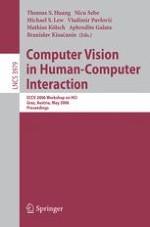The interests and goals of HCI (human–computer interaction) include und- standing, designing, building, and evaluating complex interactive systems - volving many people and technologies. Developments in software and hardware technologies are continuously driving applications in supporting our collabo- tive and communicative needs as social beings, both at work and at play. At the same time, similar developments are pushing the human–computer interface beyond the desktop and into our pockets, streets, and buildings. Developments in mobile, wearable, and pervasive communications and computing technologies provide exciting challenges and opportunities for HCI. The present volume represents the proceedings of the HCI 2006 Workshop that was held in conjunction with ECCV 2006 (European Conference on C- puter Vision) in Graz, Austria. The goal of this workshop was to bring together researchers from the ?eld of computer vision whose work is related to human– computer interaction. We solicited original contributions that address a wide range of theoretical and application issues in human–computer interaction. Wewereverypleasedbytheresponseandhadadi?culttaskofselectingonly 11 papers (out of 27 submitted) to be presented at the workshop. The accepted papers were presented in four sessions, as follows: Face Analysis – In their paper “Robust Face Alignment Based On Hierarchical Classi?er Network” authors Li Zhang,Haizhou Ai, and Shihong Lao build a hierarc- cal classi?er network that connects face detection and face alignment into a smooth coarse-to-?ne procedure. Thus a robust face alignment algorithm on face images with expressionand pose changes is introduced. Experiments are reported to show its accuracy and robustness.
